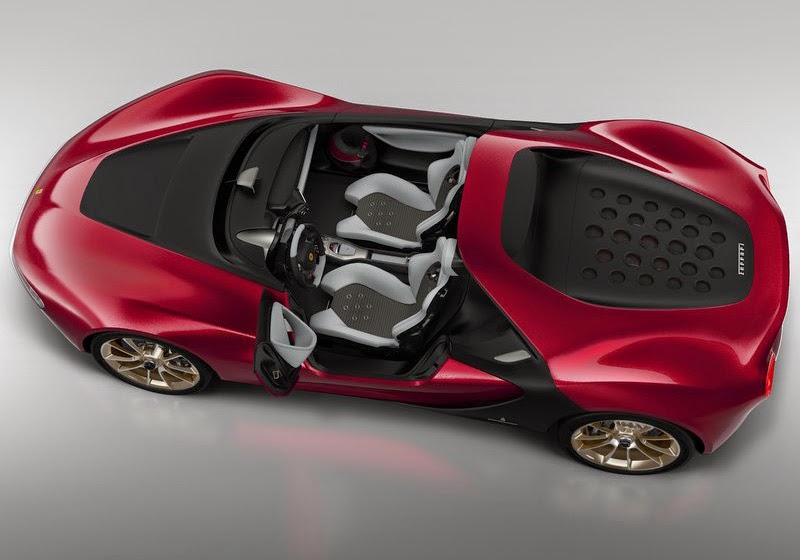Ferrari Sergio Concept, 2013
Pininfarina is presenting a concept car that renews the spirit and values of the extraordinary achievements obtained under the leadership of Sergio Pininfarina, projecting them into the future in the name of exclusivity, innovation and passion. A concept car in line with the approach that has allowed Pininfarina to generate a wealth of creations that have become car legends: the ability to combine passion, creativity, intelligence, technology and elegance in the continuity of the brand's genetic code. A mixture of aesthetic balance and elegant simplicity that last over time and make all Pininfarina models long-lived and resistant to changes in taste and fashion.
The new Pininfarina concept car could only be called Sergio. It is an exercise that Pininfarina decided to undertake on a brand that more than any other has marked the history of Pininfarina: Ferrari. The name of Sergio Pininfarina is inextricably linked to that union conceived 60 years ago: the Sergio, therefore, will also celebrate the importance of Pininfarina's contribution to the history of Prancing Horse design. A tribute that was immediately morally supported by Luca Montezemolo and Ferrari as a whole.
The two-seater barchetta of the future
With the Sergio you enter the fascinating and exciting realm of the two-seater barchetta as a unique and extreme object. Sportsmanship in the truest sense of the joy of driving, the passion of those who view cars as an unequalled source of excitement, the pleasure of admiring the essentiality of a one-off car by Pininfarina.
The sports car theme is built into Pininfarina: the fruitful collaboration with Ferrari which began in 1952, has generated some of the most popular sports cars of the postwar period. Returning to the charm of the two-seater Ferrari, compact and very sporty, is moreover, the perfect base for bonding Pininfarina's past to the future. The Sergio's mechanicals are those of the 458 Spider, which remains unchanged in its wheelbase and tracks. The formal interpretation, from which the dynamic, fluid and pure volumes spring, is absolutely free, in the best tradition of that Pininfarina design vision that has produced so many Ferrari-based concept cars recognised over time as masterpieces, such as the Mythos of 1989 and the Rossa of 2000. This approach also reminds us of Pininfarina's Ferrari-based custom-built cars such as the Testarossa Spider made for Giovanni Agnelli in 1987 or the Ferrari F360 Modena Barchetta in 2000 for Luca Montezemolo.
The result is a modern, organic view of the mid-rear-engined two-seater barchetta. The willingness to revisit volumes and surface treatments in a subliminal way emerges with the Sergio, which evokes the spirit of Pininfarina's best achievements for Ferrari of the '60s and '70s. A radical object, unique and essential, which rejects the superfluous and is performance-oriented. A real open air car with an explicit nod to racing cars, in the sense that a cupola is not fitted to protect occupants, for which two helmets are provided.
A realistic indeed quite possible concept
The modern interpretation of a barchetta is a choice consistent with one of the historical peculiarities of Pininfarina: mastery in the crafting of exceptional car bodies, capable of stirring emotions and becoming a future icon. The historical role of car body designers directed the design team towards research not on a new, hypothetical product for volume production, but on the creation of an exceptional object capable of expressing the Pininfarina DNA imprint; its exclusivity and development on the basis of a production car, in fact, places the Sergio firmly in the tradition of the great Pininfarina one-offs specifically designed for "special" clients, which makes it a real car, not just a show car.
The design theme
The Sergio is distinguished by a very simple and clear style, that becomes memorable the moment you look at it. Proportions pushed to the extreme, a dynamic front volume penetrating into a rear that is projected forward, a sculpted, three-dimensional interpretation of the typical barchetta. The composition of the two body masses through a longitudinal black insert becomes the design's guideline. Two volumes that enfold from outside to inside the car, creating a division/union line between back and front. Through the extremely fluid passage from one body to another, a form that was homogeneous in its accentuated muscularity was obtained.
The Sergio also expresses an iconicity linked to '60s Ferraris proposing bulging and sensual wings inspired by those of sports cars and racing cars of that era, achieved by compacting all volume accessories as much as possible. The extreme lightness of the Sergio, which appears to float with the front up, is a direct result of aerodynamic research. In the purest Pininfarina tradition, design is not an end in itself, but integrates functionality and aesthetics. The front semi-floating development with the spoiler under the front, expresses aesthetic force and is at the same time functional for the stabilisation of the aerodynamic load and the heat exchange. The aerodynamic deflector in front of the cockpit also creates a virtual windscreen through the deviation of the air flow, protecting the passengers from turbulence. The roll bar, designed as a wing surface, is perfectly tuned to the evolution of the flow coming from the front, adding a further down force effect. Finally, the rear nolder and the extractor close the design effectively and functionally. Still on the subject of aerodynamics, even the rear-view mirror takes on a fluid form that, given the flow of the front baffle, helps to divert air from the heads of the passengers.




No comments:
Post a Comment